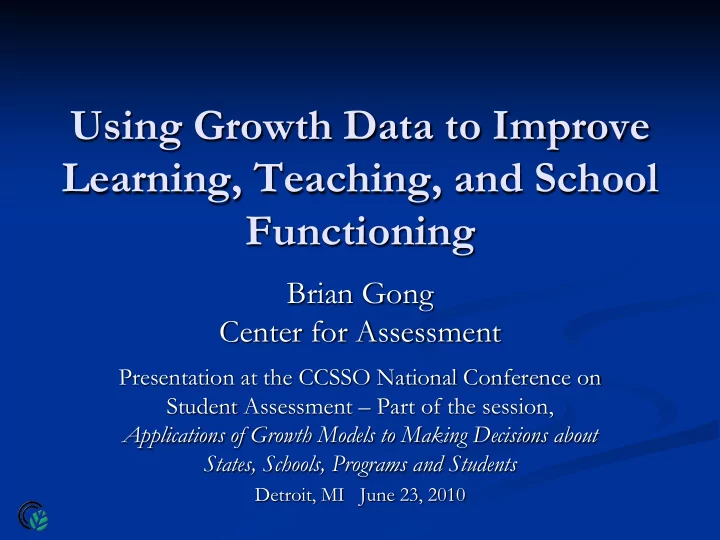

Using Growth Data to Improve Learning, Teaching, and School Functioning Brian Gong Center for Assessment Presentation at the CCSSO National Conference on Student Assessment – Part of the session, Applications of Growth Models to Making Decisions about States, Schools, Programs and Students Detroit, MI June 23, 2010
Overview Some things we know about using Growth Some important challenges to making Growth more useful Gong – Center for Assessment – “Using Growth to Improve L/T” – CCSSO NCSA 6/23/10 2
Some important things we’ve learned about growth Growth is different than Status Multiple views of performance are useful Use dictates the appropriate growth model For accountability, “good enough” growth is a key decision Gong – Center for Assessment – “Using Growth to Improve L/T” – CCSSO NCSA 6/23/10 3
Four Views of School Performance (Carlson, 2001; Gong, 2002) Status Change Achievement “Status”: How high “Improvement”: Is do students in this school the performance of score on state successive groups assessments? increasing from one year to the next? Effectiveness “Growth”: Are “Acceleration”: Is individual students the school becoming more learning as they progress effective or improving from one grade to the more rapidly? next? Gong – Center for Assessment – “Using Growth to Improve L/T” – CCSSO NCSA 6/23/10 4
Multiple views of performance can be useful Status Growth Betebenner, Jan. 2008, for RI project Gong – Center for Assessment – “Using Growth to Improve L/T” – CCSSO NCSA 6/23/10 5
Use dictates the appropriate growth/measurement model Accountability Relation to goal/criterion Program & personnel evaluation Attribution, “like” comparison Instruction Diagnosis and feedback Goldschmidt, 2004 Gong – Center for Assessment – “Using Growth to Improve L/T” – CCSSO NCSA 6/23/10 6
Deciding “good enough” growth a central issue Empirically-based Policy-based Normative Absolute What is the Criterion? Will it be Conditioned? On what? Gong & Hill, 2004 Gong – Center for Assessment – “Using Growth to Improve L/T” – CCSSO NCSA 6/23/10 7
Some challenges to making more useful growth measures Define desired growth in terms of content, in relation to curriculum Interpret in terms of scale, content, and curriculum Focus on strong uses across levels, then match measurement Gong – Center for Assessment – “Using Growth to Improve L/T” – CCSSO NCSA 6/23/10 8
Define desired growth Growth is increase in performance on the same thing, towards mastery. Growth is learning one topic and then learning a more advanced topic in a sequence of content. Growth is increase in expertise on the same thing (e.g., a more powerful mental model, increased fluency, greater independence). Growth is increase in integration across content and skills. Growth is increase of knowledge and skills outside the defined areas. Gong – Center for Assessment – “Using Growth to Improve L/T” – CCSSO NCSA 6/23/10 9
Bases for Interpretation Scale Content/skill analysis Design, e.g., standards-based Cognitive analysis Curriculum/instructional referenced “Leveled” performances Experimental design Gong – Center for Assessment – “Using Growth to Improve L/T” – CCSSO NCSA 6/23/10 10
A Use Cycle Specify Purpose & Use Choose what Use to measure Interpret Measure Gong – Center for Assessment – “Using Growth to Improve L/T” – CCSSO NCSA 6/23/10 11
Another Use Cycle Define problem & commit to improve Evaluate Hypothe- Monitor to size results solution Improve Imple- ment solution Gong – Center for Assessment – “Using Growth to Improve L/T” – CCSSO NCSA 6/23/10 12
Levels of Decisions & Actions Coherent assessment information that leads to action Comprehensive systems include all functions, levels Level of Action National/ Classroom Function District School State /Individual Signal Evaluate Inform Gong, 2008; Stiggins, 2008 Gong – Center for Assessment – “Using Growth to Improve L/T” – CCSSO NCSA 6/23/10 13
Example State – Proficiency-based Graduation Requirement District – Dropout School – Support program Gong – Center for Assessment – “Using Growth to Improve L/T” – CCSSO NCSA 6/23/10 14
References All available at www.nciea.org (“Publications & Presentations”) unless published elsewhere. Betebenner, D. (2008). Norm- and criterion-referenced student growth. Betebenner, D. (2009). Growth, standards, and accountability. Carlson, D. (2001/2006). Focusing state educational accountability systems: Four methods of judging school quality and progress. Goldschmidt, P. (2004). Models for school accountability and program evaluation. Presentation at the 2004 RILS conference. Gong, B. (2002). Designing school accountability systems. (with ASR SCASS) Washington, DC: CCSSO. Gong, B. & Hill, R. (2004). Using student growth measures in school accountability. Gong, B. (2008). Assessment, learning, equity: What will it take to move to the next level? Stiggins, R. (2008). Assessment FOR learning, the Achievement Gap, and truly effective schools. http://www.ets.org/Media/Conferences_and_Events/pdf/stiggins.pdf Gong – Center for Assessment – “Using Growth to Improve L/T” – CCSSO NCSA 6/23/10 15
For more information: Center for Assessment www.nciea.org Brian Gong bgong@nciea.org Gong – Center for Assessment – “Using Growth to Improve L/T” – CCSSO NCSA 6/23/10 16
Recommend
More recommend